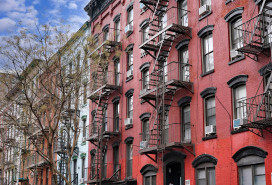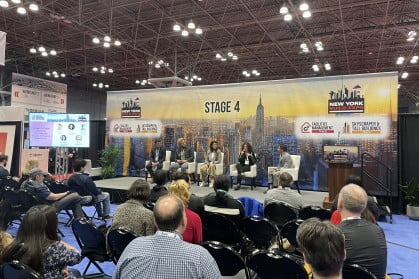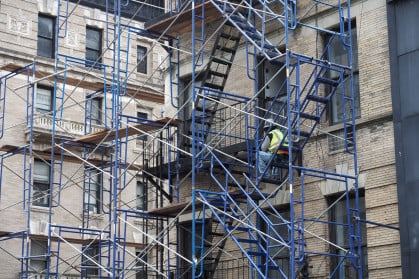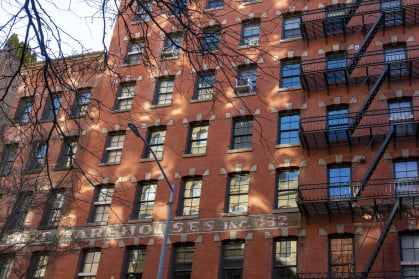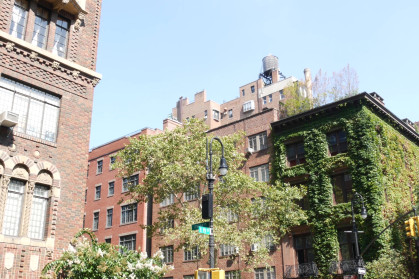
What NYC regulations around infrastructure and energy apply to NYC co-op and condo buildings?
Co-ops and condos need to comply with a seemingly ever-expanding number of regulations. Many of these are geared toward making aging infrastructure safe for residents and passers-by, while a new crop of ambitious legislation aims to drastically reduce carbon emissions across the city's housing stock.
Here are the major energy and infrastructure regulations that your building may need to comply with along with some signs that you may not be in compliance, and a general sense of the costs your building may incur.
| Building Envelope | In accordance with the NYC DOB Façade Inspection Safety Program (FISP), formerly Local Law 11 of 1998, every five years a façade inspection must be performed on all buildings that are greater than six stories in height. These inspections must be accompanied by a report submitted to the Department of Buildings (DoB) describing the building as either;
Cost: The cost for FISP can be substantial and as regulations have become stricter, it has increased over the years. |
|---|---|
| HVAC | There are several regulations in NYC that pertain to the HVAC systems of co-op and condo buildings. A more in-depth explanation of these are located under Brick Underground's Sustainability vertical.
Cost: The cost to upgrade or replace the HVAC system is substantial and it requires careful planning and consideration. |
| Plumbing | There are national, state and city plumbing codes intended to ensure that the systems are safe, efficient, and in compliance with local codes and standards. Some of the main regulations include:
Cost: Most of the plumbing system is located inside the walls and not immediately visible to inspect or maintain, or even replace. Old plumbing pipes can become corroded, damaged, brittle, or clogged, which can lead to leaks, blockages, or even burst pipes. These leaks can cause massive water damage to the building, increase the water bill, as well as insurance premiums. The cost of replacing the piping inside the walls can be significant, not to mention the inconvenience for residents. |
| Electrical | The electrical systems of NYC buildings are regulated by federal, state, and local electrical and building codes. They are also regulated by the NYC Fire Code. Look out for: Be aware of signs of electrical issues such as flickering lights or burning smells. Cost: Because a majority of buildings’ wiring and components are inside the walls, it is difficult to inspect and repair them, which can lead to safety hazards. Electrical boxes are typically visible, both the electrical main panel in the basement, and the electrical boxes inside the apartments. These are quite costly to replace. However, the Inflation Reduction Act provides rebates and incentives for both the boxes themselves as well as the work. |
| Elevators | In response to an increase in elevator accidents, due in part to aging elevators, the DOB added four regulations in recent years.
These regulations and inspections might seem like a hassle, but they are all there to keep everyone safe. Part of a board’s job is to keep up with new regulations, so communicating with the property manager, the elevator consultant, or elevator service provider is an important part of serving on the board. Cost: Elevators are quite expensive to replace. The upside is that it only needs to be done every 30-50 years. Inconvenience: Replacing elevators, aka modernization, or elevator mod in short, is a huge inconvenience for New York residents, especially in the buildings that only have one elevator. Boards need to carefully plan and schedule the elevator mod with consideration for all residents. |
| Parking Garages & Parapet Inspections | In accordance with Local Law 126 of 2021, parking garages with more than three parking spaces need to meet the Periodic Inspection Requirements. The law requires owners of parking structures to have their garages inspected every six years, and to file a report with inspection results to the Department of Buildings. Inspections and reports must be conducted by a Qualified Parking Structures Inspector (QPSI). QPSI’s will create an annual observation checklist during the initial assessment prescribing baseline inspection items to be assessed annually or at more frequent intervals by or on behalf of the parking structure owner. Local Law 126 also requires buildings taller than two stories to inspect their parapet annually. Cost: The cost for LL126 can be substantial, especially the first cycle, which started on January 1, 2022. |
Sign Up for our Boards & Buildings Newsletter (Coming Soon!)
Thank you for your interest in our newsletter. You have been successfully added to our mailing list and will receive it when it becomes available.



